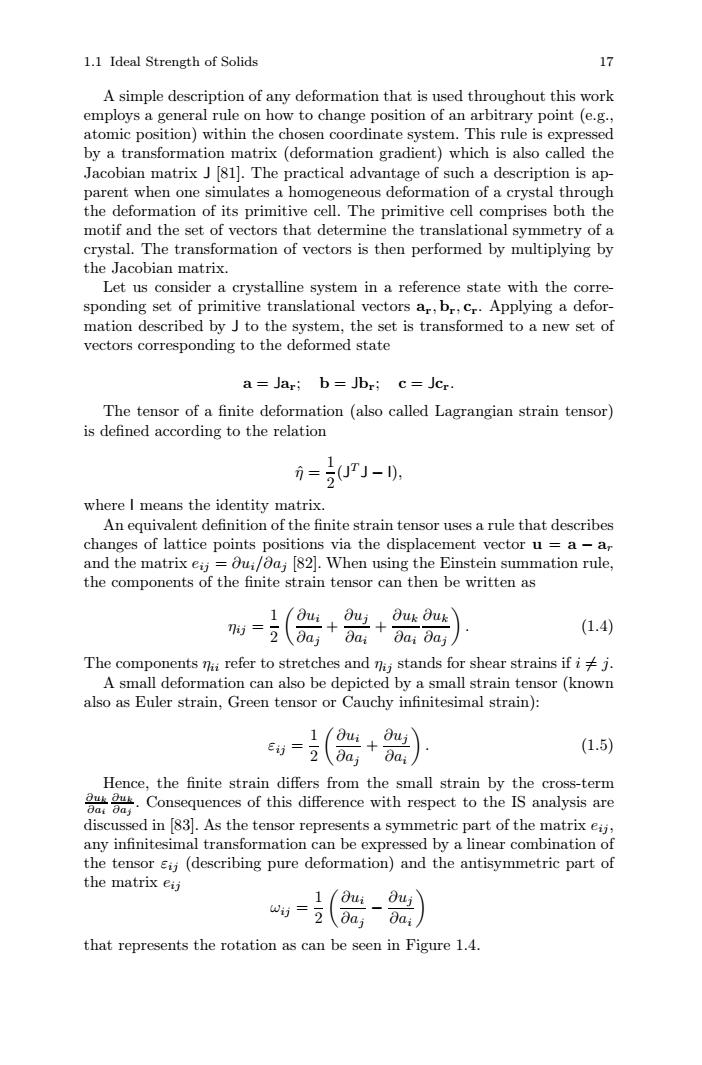正在加载图片...

1.1 Ideal Strength of Solids 17 A simple description of any deformation that is used throughout this work employs a general rule on how to change position of an arbitrary point (e.g., atomic position)within the chosen coordinate system.This rule is expressed by a transformation matrix (deformation gradient)which is also called the Jacobian matrix J 81.The practical advantage of such a description is ap- parent when one simulates a homogeneous deformation of a crystal through the deformation of its primitive cell.The primitive cell comprises both the motif and the set of vectors that determine the translational symmetry of a crystal.The transformation of vectors is then performed by multiplying by the Jacobian matrix. Let us consider a crystalline system in a reference state with the corre- sponding set of primitive translational vectors ar,br,cr.Applying a defor- mation described by J to the system,the set is transformed to a new set of vectors corresponding to the deformed state a=Jar;b=Jbr;c=JCr The tensor of a finite deformation (also called Lagrangian strain tensor) is defined according to the relation =0P小-0, where I means the identity matrix. An equivalent definition of the finite strain tensor uses a rule that describes changes of lattice points positions via the displacement vector u a-ar and the matrix eij oui/Oaj [82].When using the Einstein summation rule, the components of the finite strain tensor can then be written as 1(u+u+ Ouk Ouk n=2∂a (1.4) 8ai Dai dai The components nii refer to stretches and ni stands for shear strains if ij. A small deformation can also be depicted by a small strain tensor(known also as Euler strain,Green tensor or Cauchy infinitesimal strain): (+ (1.5) Hence,the finite strain differs from the small strain by the cross-term uu.Consequences of this difference with respect to the IS analysis are Bai Baj discussed in [83].As the tensor represents a symmetric part of the matrix eij, any infinitesimal transformation can be expressed by a linear combination of the tensor sij (describing pure deformation)and the antisymmetric part of the matrix eij 1 dui 2 da that represents the rotation as can be seen in Figure 1.4.1.1 Ideal Strength of Solids 17 A simple description of any deformation that is used throughout this work employs a general rule on how to change position of an arbitrary point (e.g., atomic position) within the chosen coordinate system. This rule is expressed by a transformation matrix (deformation gradient) which is also called the Jacobian matrix J [81]. The practical advantage of such a description is apparent when one simulates a homogeneous deformation of a crystal through the deformation of its primitive cell. The primitive cell comprises both the motif and the set of vectors that determine the translational symmetry of a crystal. The transformation of vectors is then performed by multiplying by the Jacobian matrix. Let us consider a crystalline system in a reference state with the corresponding set of primitive translational vectors ar, br, cr. Applying a deformation described by J to the system, the set is transformed to a new set of vectors corresponding to the deformed state a = Jar; b = Jbr; c = Jcr. The tensor of a finite deformation (also called Lagrangian strain tensor) is defined according to the relation ηˆ = 1 2 (JT J − I), where I means the identity matrix. An equivalent definition of the finite strain tensor uses a rule that describes changes of lattice points positions via the displacement vector u = a − ar and the matrix eij = ∂ui/∂aj [82]. When using the Einstein summation rule, the components of the finite strain tensor can then be written as ηij = 1 2 ∂ui ∂aj + ∂uj ∂ai + ∂uk ∂ai ∂uk ∂aj . (1.4) The components ηii refer to stretches and ηij stands for shear strains if i = j. A small deformation can also be depicted by a small strain tensor (known also as Euler strain, Green tensor or Cauchy infinitesimal strain): εij = 1 2 ∂ui ∂aj + ∂uj ∂ai . (1.5) Hence, the finite strain differs from the small strain by the cross-term ∂uk ∂ai ∂uk ∂aj . Consequences of this difference with respect to the IS analysis are discussed in [83]. As the tensor represents a symmetric part of the matrix eij , any infinitesimal transformation can be expressed by a linear combination of the tensor εij (describing pure deformation) and the antisymmetric part of the matrix eij ωij = 1 2 ∂ui ∂aj − ∂uj ∂ai that represents the rotation as can be seen in Figure 1.4